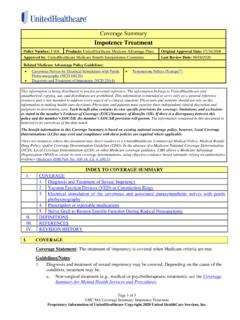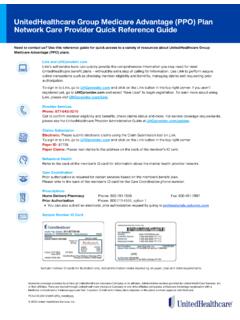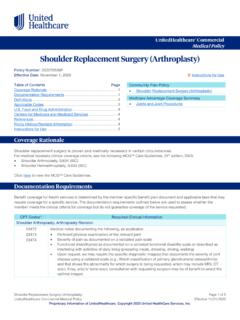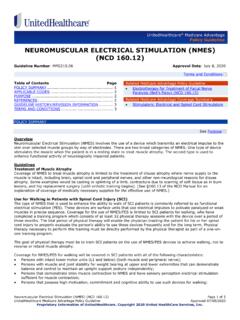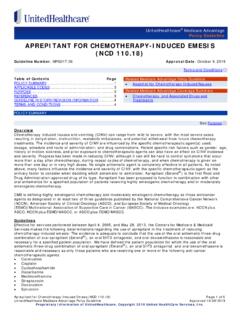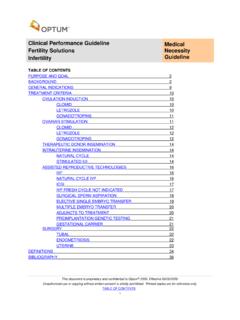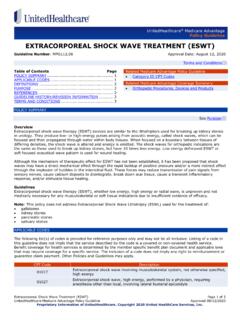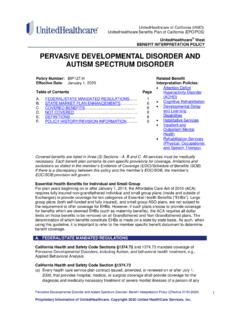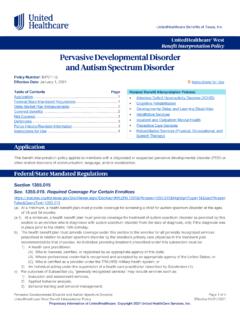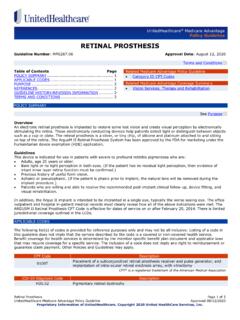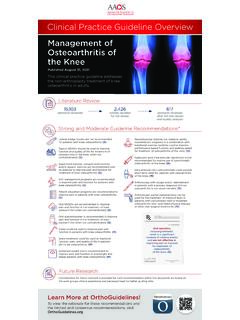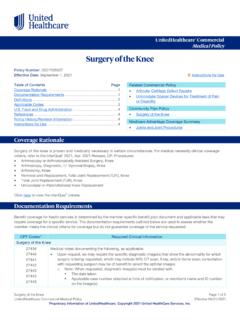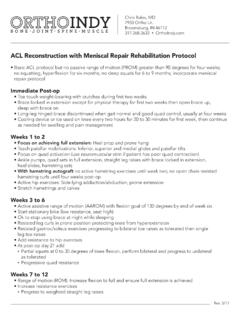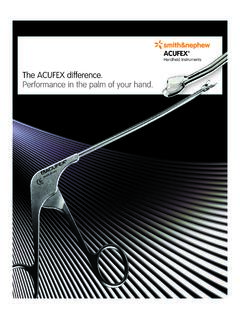Transcription of Articular Cartilage Defect Repairs - UHCprovider.com
1 UnitedHealthcare Commercial Medica l Policy Articular Cartilage Defect Repairs Policy Number: 2022T0030X. Effective Date: May 1, 2022 Instructions for Use Table of Contents Page Related Commercial Policy Coverage Rationale .. 1 Surgery of the knee Documentation 2. Outpatient Surgical Procedures Site of Service Definitions .. 3. Applicable Codes .. 4 Community Plan Policy Description of Services .. 5 Articular Cartilage Defect Repairs Clinical 6. Food and Drug 16. References .. 17. Policy History/Revision Information .. 19. Instructions for 19. Coverage Rationale ACT and Microfracture Autologous chondrocyte transplantation (ACT) is proven and medically necessary for treating individuals with symptomatic full-thickness Articular Cartilage defects when all of the following criteria are met: The lesion is: o Greater than or equal to 2 squared centimeters o A result of acute or repetitive trauma o Single or multiple full thickness (Outerbridge Classification of grade III or IV) Articular Cartilage Defect of the femoral condyle (medial, lateral or trochlea) and/or patella knee is stable with intact menisci and ligaments Normal joint space and alignment confirmed by X-ray No active inflammatory or other arthritis, clinically and by X-ray Failed non-surgical conservative management ( , physical therapy, braces, and/or nonsteroidal anti-inflammatory drugs).
2 Inadequate response to a prior arthroscopic or other surgical repair procedure ( , debridement, microfracture, drilling/abrasion arthroplasty, or osteochondral allograft/autograft). Individual is less than 55 years of age. ACT is unproven and not medically necessary for treating individuals with the following indications due to insufficient evidence of efficacy: Treatment of joints other than the knee Growth plates have not closed History of partial -thickness defects Osteochondritis dissecans (OCD). Malignancy in the bone, Cartilage , fat or muscle of the treated limb Active infection in the affected knee Instability of the knee History of total meniscectomy Repeat ACT. Articular Cartilage Defect Repairs Page 1 of 20. UnitedHealthcare Commercial Medical Policy Effective 05/01/2022. Proprietary Information of UnitedHealthcare. Copyright 2022 United HealthCare Services, Inc. Active inflammatory degenerative, rheumatoid or osteoarthritis As initial or first line of surgical therapy Microfracture repair to treat full and partial thickness chondral defects of the knee is proven and medically necessary when all of the following criteria are me: Symptomatic focal Cartilage defects of the weight-bearing femoral condyles, tibial plateau, trochlea, and patella Defect has been identified by Magnetic resonance imaging (*MRI), arthrogram or arthroscopy Outerbridge Grade 3-4 Cartilage lesions Measure less than or equal to 4 square centimeters Osteochondral Autograft and Allograft Transplantation Osteochondral Autograft and Allograft transplantation is proven and medically necessary for treating individuals with Cartilage defects of the knee .
3 For medical necessity clinical coverage criteria for Osteochondral Autograft and Allograft Transplantation, refer to the InterQual 2022, Apr. 2022 Release, CP: Procedures: Arthroscopy or Arthroscopically Assisted Surgery, knee Arthroscopy or Arthroscopically Assisted Surgery, knee (Pediatric). Arthrotomy, knee Click here to view the InterQual criteria. Focal Articular Cartilage repair Focal Articular Cartilage repair is unproven and not medically necessary for treating individuals with any of the following due to insufficient evidence of efficacy: Osteochondral Autograft and Allograft transplantation for all other indications than those listed above Use of minced Articular Cartilage repair (whether synthetic, allograft or autograft) for treating osteochondral defects of the knee Use of cryopreserved viable Osteochondral Allograft products ( , Cartiform). Microfracture repair of the knee with any of the following indications: o Misalignment of the knee o Osteoarthritis o Systemic immune-mediated disease, disease-induced arthritis, or Cartilage disease o Unwilling or unable to participate in post-operative physical rehabilitation program Documentation Requirements Benefit coverage for health services is determined by the member specific benefit plan document and applicable laws that may require coverage for a specific service.
4 The documentation requirements outlined below are used to assess whether the member meets the clinical criteria for coverage but do not guarantee coverage of the service requested. CPT/HCPCS. Required Clinical Information Codes*. Autologous Chondrocyte Transplantation 27412, 27415, Medical notes documenting the following, when applicable: 27416, 29866, Complete report(s) of diagnostic imaging (MRI, CT scan, X-rays and bone scan). 29867, 29879, o Documented closure of skeletal plates (age less than 18 years). J7330, S2112. o Presence or absence of focal full-thickness Articular Cartilage Defect o Size and location of focal Cartilage Defect o Outerbridge grade o Joint space and alignment Condition requiring procedure Articular Cartilage Defect Repairs Page 2 of 20. UnitedHealthcare Commercial Medical Policy Effective 05/01/2022. Proprietary Information of UnitedHealthcare. Copyright 2022 United HealthCare Services, Inc.
5 CPT/HCPCS. Required Clinical Information Codes*. Autologous Chondrocyte Transplantation Symptoms Severity of pain and details of functional disability(ies) interfering with activities of daily living (preparing meals, dressing, driving, walking, etc.). Pertinent physical examination of the relevant joint Cause of Defect ; , acute or repetitive trauma Co-morbid medical condition(s). Prior therapies/treatments tried, failed, or contraindicated; include the dates and reason for discontinuation Physician's treatment plan including pre-op discussion If the location is being requested as an inpatient stay, provide office notes to support at least one of the following: o Surgery is bilateral o Member has significant co-morbidities; include the list of comorbidities and current treatment o Member does not have appropriate resources to support post-operative care after an outpatient procedure; include the barriers to care as an outpatient *For code descriptions, refer to the Applicable Codes section.
6 Definitions Allografts: Grafts of bone and Cartilage harvested from a cadaver joint (may be fresh or cryopreserved), which is then implanted in the Defect (AAOS, 2011). Allograft: The transplant of an organ, tissue, or cells from one individual to another individual of the same species who is not an identical twin (National Cancer Institute, 2017). Allograft Discs ( , Cartiform, ProChondrix CR): Wafer-thin allografts where the bony portion of the allograft is reduced. The discs contain hyaline Cartilage with chondrocytes, growth factors, and extracellular matrix proteins. The graft is often used in conjunction with marrow stimulation purportedly allowing the host mesenchymal stem cells to infiltrate the graft from the underlying bone marrow after stimulation to provide dense extracellular matrix intended to enhance biomechanical stability and promote chondrogenesis (Hayes, 2018). Autografts: Grafts of bone and Cartilage harvested from either the patient's non-weight bearing surfaces (or surfaces that bear less weight), which is then implanted in the Defect .
7 Autografting is typically used to repair smaller defects . Tissue transplanted from one part of the body to another in the same individual (AAOS, 2011). Autologous Chondrocyte Transplantation (ACT): Also referred to as autologous chondrocyte implantation (ACI), is a form of tissue engineering that creates a graft from a patient's own Cartilage cells to repair defects in the Articular Cartilage . For first- generation ACI, the process involves removal, expansion (culture), and reimplantation of the patient's own chondrocytes under a piece of periosteal membrane that is excised from the tibia of the patient and sutured over the site of knee injury. With ACT, a region of healthy Articular Cartilage is identified and biopsied through arthroscopy. The tissue is sent to a facility licensed by the Food and Drug Administration (FDA) where the chondrocytes are separated.(Camp et al., 2014). Focal Defect : A Defect of the Articular Cartilage due to any inflammation, injury, or trauma causing partial or full thickness Cartilage Defect in a well-defined focal area.
8 Femoral Condyles: Large flared prominences on the distal end of the femur, identified as lateral and medical femoral condyles. They are covered with a thick layer of hyaline Cartilage and articulate with the patella and the tibia at the knee joint. Juvenile Cartilage Allograft Tissue Implantation ( , DeNovo NT Natural Tissue Graft): A tissue based Articular Cartilage graft that is processed from healthy donors less than 13 years of age and greater than 6 lbs. in weight. Donors are sourced through appropriate Organ and Tissue Procurement Organizations (OTPOs) (Hayes, 2018). Articular Cartilage Defect Repairs Page 3 of 20. UnitedHealthcare Commercial Medical Policy Effective 05/01/2022. Proprietary Information of UnitedHealthcare. Copyright 2022 United HealthCare Services, Inc. Matrix-Induced Autologous Chondrocyte Implantation (MACI) Procedure: MACI is a multistage procedure using autologous cultured chondrocytes on porcine collagen membrane.
9 The procedure involves 2 surgeries. During an initial arthroscopic surgery, a biopsy of healthy Cartilage is obtained. The Cartilage sample is then sent to a laboratory where chondrocytes are isolated from the biopsy and expanded in vitro for a period of weeks. After an appropriate concentration of chondrocytes has been achieved, the chondrocytes are seeded onto a 3-dimensional matrix. Then, during a second surgical procedure (with arthroscopic or mini-arthrotomy approach), surgeons conduct a debridement of the damaged Cartilage site and glue the seeded matrix to fill the entirety of the Defect (Hayes, 2020). Minced Cartilage repair : This procedure uses minced pieces of Cartilage seeded over a scaffold which allows for even distribution of the chondrocytes to expand within the Defect providing structural and mechanical protection (McCormick et al., 2008). Microfracture: Microfracture utilizes the body's healing potential and stem cells found in bone marrow to initiate Cartilage growth.
10 Cartilage is first debrided, and the calcified layer of bone is removed. Then the surgeon makes microfractures (small holes) in the subchondral bone exposing the bone marrow creating a blood clot in the chondral Defect , ultimately recruiting mesenchymal stem cells that heal the Defect with a fibrocartilaginous scar (Weber, 2018). Mosacicplasty: A technique of creating an osteochondral autograft by harvesting and transplanting multiple small cylindrical osteochondral plugs from the less weight-bearing periphery of the patellofemoral area and inserting them into drilled tunnels in the defective section of Cartilage (International Cartilage Regeneration and Joint Preservation Society, 2018). Osteochondral Allograft (OCA): Involves transplantation of a piece of Articular Cartilage and attached subchondral bone from a cadaver donor to a damaged region of the Articular surface of a joint. The goal of this procedure is to provide viable chondrocytes and supporting bone that will be sufficient to maintain the Cartilage matrix and thereby relieve pain and reduce further damage to the Articular surface of the joint (International Cartilage Regeneration and Joint Preservation Society, 2018).
